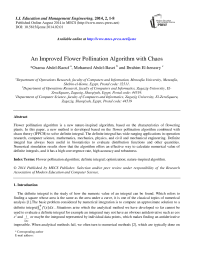An Improved Flower Pollination Algorithm with Chaos
Автор: Osama Abdel-Raouf, Mohamed Abdel-Baset, Ibrahim El-henawy
Журнал: International Journal of Education and Management Engineering(IJEME) @ijeme
Статья в выпуске: 2 vol.4, 2014 года.
Бесплатный доступ
Flower pollination algorithm is a new nature-inspired algorithm, based on the characteristics of flowering plants. In this paper, a new method is developed based on the flower pollination algorithm combined with chaos theory (IFPCH) to solve definite integral. The definite integral has wide ranging applications in operation research, computer science, mathematics, mechanics, physics, and civil and mechanical engineering. Definite integral has always been useful in biostatistics to evaluate distribution functions and other quantities. Numerical simulation results show that the algorithm offers an effective way to calculate numerical value of definite integrals, and it has a high convergence rate, high accuracy and robustness.
Flower pollination algorithm, definite integral, optimization, nature-inspired algorithm
Короткий адрес: https://sciup.org/15013827
IDR: 15013827
Список литературы An Improved Flower Pollination Algorithm with Chaos
- Rao, S. S. (2001). Applied numerical methods for engineers and scientists. Prentice Hall Professional Technical Reference.
- Kreyszig, E. (2007). Advanced engineering mathematics. John Wiley & Sons.
- Davis, P. J., & Rabinowitz, P. (2007). Methods of numerical integration. Courier Dover Publications.
- Forsythe, G. E., Moler, C. B., & Malcolm, M. A. (1977). Computer methods for mathematical computations.
- Press, W. H., Teukolsky, S. A., Vetterling, W. T., & Flannery, B. P. (1992). Numerical Recipes: The art of scientific computing (Cambridge.
- Hildebrand, F. B. (1987). Introduction to numerical analysis. Courier Dover Publications.
- Abdel-Raouf, O., Abdel-Baset, M., & El-henawy, I. (2014). A New Hybrid Flower Pollination Algorithm for Solving Constrained Global Optimization Problems. International Journal of Applied, 4(2), 1-13.
- Abdel-Raouf, O., El-henawy, I., & Abdel-Baset, M. (2014). Chaotic Harmony Search Algorithm with Different Chaotic Maps for Solving Assignment Problems. International Journal of Computer Applications, 86(10), 8-13.
- Yang, D., Li, G., & Cheng, G. (2007). On the efficiency of chaos optimization algorithms for global optimization. Chaos, Solitons & Fractals, 34(4), 1366-1375.
- Gandomi, A. H., Yun, G. J., Yang, X. S., & Talatahari, S. (2013). Chaos-enhanced accelerated particle swarm optimization. Communications in Nonlinear Science and Numerical Simulation, 18(2), 327-340.
- Alatas, B. (2010). Chaotic harmony search algorithms. Applied Mathematics and Computation, 216(9), 2687-2699.
- Gong, W., & Wang, S. (2009, December). Chaos ant colony optimization and application. In Internet Computing for Science and Engineering (ICICSE), 2009 Fourth International Conference on (pp. 301-303). IEEE.
- Alatas, B. (2010). Chaotic bee colony algorithms for global numerical optimization. Expert Systems with Applications, 37(8), 5682-5687.
- Gandomi, A. H., Yang, X. S., Talatahari, S., & Alavi, A. H. (2013). Firefly algorithm with chaos. Communications in Nonlinear Science and Numerical Simulation, 18(1), 89-98.
- Mingjun, J., & Huanwen, T. (2004). Application of chaos in simulated annealing. Chaos, Solitons & Fractals, 21(4), 933-941.
- Coelho, L. D. S., & Mariani, V. C. (2008). Use of chaotic sequences in a biologically inspired algorithm for engineering design optimization. Expert Systems with Applications, 34(3), 1905-1913.
- Tavazoei, M. S., & Haeri, M. (2007). Comparison of different one-dimensional maps as chaotic search pattern in chaos optimization algorithms. Applied Mathematics and Computation, 187(2), 1076-1085.
- Corron, N. J., Hayes, S. T., Pethel, S. D., & Blakely, J. N. (2006). Chaos without nonlinear dynamics. Physical review letters, 97(2), 024101.
- He, D., He, C., Jiang, L. G., Zhu, H. W., & Hu, G. R. (2001). Chaotic characteristics of a one-dimensional iterative map with infinite collapses. Circuits and Systems I: Fundamental Theory and Applications, IEEE Transactions on, 48(7), 900-906.
- Erramilli, A., Singh, R. P., & Pruthi, P. (1994). Modeling packet traffic with chaotic maps. KTH.
- May, R. M. (1976). Simple mathematical models with very complicated dynamics. Nature, 261(5560), 459-467.
- Wolf, A. (1986). Quantifying chaos with Lyapunov exponents. Chaos, 273-290.
- Devaney, R. L. (1989). An introduction to chaotic dynamical systems (Vol. 6). Reading: Addison-Wesley.
- Peitgen, H. O., Jürgens, H., & Saupe, D. (2004). Chaos and fractals: new frontiers of science. Springer.
- Ott, E. (2002). Chaos in dynamical systems. Cambridge university press.
- Letellier, C. (2013). Chaos in nature (Vol. 81). World Scientific.
- Qu, L., & He, D. (2010). Solving Numerical Integration by Particle Swarm Optimization. In Information Computing and Applications (pp. 228-235). Springer Berlin Heidelberg.


